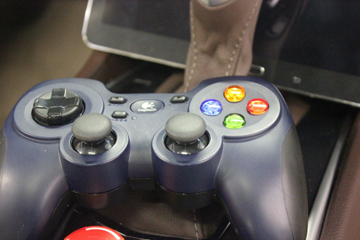MCLEAN, Va. – While Taylor Lochrane was driving through a heavy rainstorm in Virginia, the lack of visibility didn’t worry him.
He pressed a few buttons on the Cadillac SRX Crossover’s console, allowing the vehicle’s cruise control to maintain a large gap between his car and the one he was following, preventing a possible crash.
“The radar could see the car, even though I couldn’t,” he said.
The Cadillac’s radar adds another layer to regular cruise control, making it able to react to the environment using what is called adaptive cruise control.
As a research civil engineer at the federal Turner-Fairbank Highway Research Center, Lochrane is adding another layer to inter-vehicle communication. Adaptive cruise control is on the market, but it doesn’t allow vehicles to talk to each other. At the Highway Research Center, they’ve built a prototype for what they call cooperative adaptive cruise control, a step toward driverless cars.
“We’re hijacking the vehicle’s commands and sending our own,” he said.
Developing these technologies is part of the Department of Transportation’s effort to make the nation’s highways and byways more efficient.
“The big thing for us is getting people there on time,” Joe Peters, director of operations research and development at Turner-Fairbank said. Despite pushes to add more roads, Peters said that would only be a short-term fix. “We can’t build our way out.”
The Federal Communications Commission reserved part of the broadcast spectrum – 5.9 gigahertz – for DOT. This allows vehicles, stoplights or buildings, to ping each other 10 times a second, which is quick enough to respond to something unexpected on the road. This technology could display alerts of upcoming travel conditions, so the driver is more aware of what’s coming next.
“That quick response saves lives,” Peters said.
Test vehicles like the Cadillac allow the research center to test software that could help with more complicated maneuvers such as merging and weaving through traffic.
An off-brand X-Box controller is connected to the vehicle’s console, and a tablet computer shows video coming from four cameras inside the vehicle, which allows researchers another chance to see how a test drive went. Thanks to an in-vehicle wireless network, everything is connected and automated.
“All the driver has to do is steer,” Lochrane said.
In addition to cooperative adaptive cruise control, researchers are working on other technologies to improve inter-vehicle communication:
- Speed harmonization would allow drivers to receive alerts on a suggested travel speed. This could reduce congestion around bottlenecks, and with the help of intelligent intersections, inform drivers how they can avoid red lights.
- Truck platooning would allow trucks to drive closer together, saving fuel.
- Intelligent intersections could adjust signal times based on traffic, improving traffic flow.
The Intelligent Transportation Society of America estimates that installing this technology would add less than $200 to a new vehicle’s price tag.
Adding technology that could broadcast location and other driving-related information raises some eyebrows.
But after allowing a group of beta testers try out various vehicle-to-vehicle communications systems, nine out of 10 said they’d like it in their own vehicles.
As for when this technology will be available, researchers and the National Highway Traffic Safety Administration can’t say.
Once it’s built, it will be up to the auto manufacturers to start including in their new vehicles.
“This is research,” Lochrane said. “It takes time.”
This story was previously published by the Scripps Howard Foundation Wire. It is republished here under SHFwire’s guidelines.



Interesting detail for those following current events. Ten pings per second equal 600 pings pero minutes this is the cyclic rate of fire for a fully automatic Uzi. No further comment necessary I’m sure. Quick enough for another car to respond, perhaps, but not a human being.